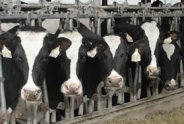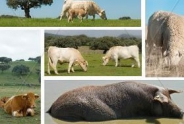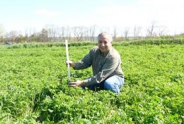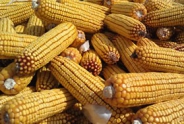Grazing
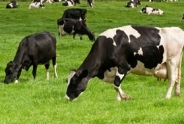 For links to more resources that contain diverse information about grazing animals in our region, 'View Complete List of Grazing Content' at the bottom of the page, or type into the search bar above.
For links to more resources that contain diverse information about grazing animals in our region, 'View Complete List of Grazing Content' at the bottom of the page, or type into the search bar above. Relevant Event
Winter Bale Grazing Pasture Walk
January 10, 2026
Truxton, NY
Grazing Heifers - An Opportunity for Large Dairy Farms
A. Fay Benson, Small Dairy Extension Educator
South Central New York Dairy & Field Crops
Grazing Heifers - An Opportunity for Large Dairy Farms
This booklet, authored by Fay Benson, explains the management and opportunity to reduce the costs of raising dairy heifers by utilizing Management Intensive Grazing for a portion of the heifer's life. This savings can be substantial since the dairy heifer program on Dairies is 25-30% of milk production costs according to Penn State's "Heifer Economics".
CONTENTS: An Overview of economics and 10 Fact Sheets covering the resources required to operate a farm owned heifer grazing system or contracting with a Custom Grazer.
1. Grazing Management
2. Nutrition
3. Animal Control and Movement
4. Infrastructure: Fencing
5. Infrastructure: Water
6. Immunity and Vaccination
7. Fly Control
8. Avoiding Pasture Pitfalls
9. Grazing Checklist
10. Custom Grazing Contract
Custom Machinery Rates
Nancy Glazier, Small Farms & Livestock Specialist
Northwest New York Dairy, Livestock & Field Crops
Trying to figure out how much to pay or charge for custom machinery operations? Check out the 2016 custom rate summaries from Pennsylvania.
Soil Sampling for Field Crops
Bill Verbeten, Field Crops
Northwest New York Dairy, Livestock & Field Crops

Not sure how to sample your soil? Download this Cornell Agronomy Fact Sheet. More Agronomy Fact Sheets are available at the Cornell Nutrient Management Spear Program website.
Alfalfa Management Guide
Bill Verbeten, Field Crops
Northwest New York Dairy, Livestock & Field Crops

Have a question about growing alfalfa? You will probably find the answer in "The Alfalfa Management Guide". This is a must have reference for anyone working with "the queen of forages".
Getting the Most Out of Your Manure Presentation
Bill Verbeten, Field Crops
Northwest New York Dairy, Livestock & Field Crops

There are many practical, cost-effective manure management practices can be adopted on farms of all sizes.
Apps for Ag
Nancy Glazier, Small Farms & Livestock Specialist
Northwest New York Dairy, Livestock & Field Crops
List of some apps for smartphone users.
Annual Farm Business Summary and Analysis Season Is Right Around The Corner
John Hanchar, Farm Business Management Specialist
Northwest New York Dairy, Livestock & Field Crops
- Sound financial planning and control are keys to successfully managing agricultural risks.
- The next few months present good opportunities to evaluate your business' financial management practices.
- The NWNY Dairy, Livestock, and Field Crops Program has the capacity to work with a variety producers as they seek to improve their business' financial management practices.
Grazing in the Grass - The Movie
A. Fay Benson, Small Dairy Extension Educator
South Central New York Dairy & Field Crops
This video shows Tim Willsallen's farm in Tompkins County NY, and how he manages his pasture to feed a flock of 1000 sheep year round and also custom grazes 70 head of dairy heifers for the summer. He uses turnips for winter grazing and has a unique fence set up with no gates and he changes the fence while the elcectricty is still on.
Sprouted Barley Fodder
A. Fay Benson, Small Dairy Extension Educator
South Central New York Dairy & Field Crops

This Facebook group serves as a forum for dairy farmers who want to know more about using sprouted barley fodder as feedstock. Connect to the community of barley fodder producers and dairy farmers by posting questions and pictures and engaging with the group's resources, including a webinar with John Stultzfus of Be-A-Blessing Organic Dairy, and Fay Benson from Cornell University.
Upcoming Events
Winter Bale Grazing Pasture Walk
January 10, 2026
Truxton, NY
Boots in the Barn: Webinar Series
January 13, 2026
2026 Winter Crop Meeting - Auburn
January 22, 2026
Auburn, NY
Announcements
USDA Contract Freezes and Terminations: Legal Action Steps for Farmers
For Farmers with Signed EQIP and CSP ContractsThis resource is written for farmers and ranchers nationwide who have a signed contract with USDA NRCS under the EQIP or CSP program for environmental improvements but have concerns that their contract is frozen, under review, or terminated, and who are uncertain of their rights to receive reimbursement as well as their ongoing obligations under the signed contract.
Version: 1.0
Issue date: Feb 28, 2025
A downloadable factsheet is available at our BUSINESS tab on the top of our webpage.
Additional Information: www.farmcommons.org
USDA Contract Freezes: Filing an NAD Appeal or Demand Letter
This resource is written for farmers and ranchers nationwide who have a signed contract with USDA NRCS under the EQIP or CSP program for environmental improvements and want more information on the mechanics of filing a National Appeals Division (NAD) appeal. This resource includes sample letters.
USDA NAD Appeal https://www.usda.gov/about-usda/general-information/staff-offices/office-hearings-and-appeals/national-appeals-division/nad-appeals
Farm Participants Needed for Bale Grazing Grant!
Information on the Project:- Approximately 10 acres total needed to bale graze two different bale densities
- "Core" farms will graze two winters, "Demo" farms will graze one winter.
- Payments for both "Core" farms and "Demo" farms
- Baseline soil sampling by bale grazing team
- Forage measurements in early season by bale grazing team
- Late season clipping if residual not trampled down by farm
Cornell Cow Convos - New Podcast
On-going podcast, New episodes released on the last Thursday of the month.Guest speakers, CCE Dairy Specialists.
Housed on Soundcloud Channel is CCE Dairy Educators
- Preventative healthcare for cows
- The trend of beef on dairy
- What to look forward to in the new year for dairy
- Socially grouping or pair-housing calves
2018 Drug Residue Prevention Manual
For more than 30 years, the U.S. dairy industry has focused educational efforts on the judicious use of antibiotics through the annual publication of a Best Practices Manual. The 2018 edition of the National Dairy FARM Program: Farmers Assuring Responsible Management? Milk and Dairy Beef Drug Residue Prevention Manual is the primary educational tool for dairy farm managers throughout the country on the judicious and responsible use of antibiotics, including avoidance of drug residues in milk and meat.The manual is a quick resource to review those antibiotics approved for dairy animals and can also be used as an educational tool and resource for farm managers as they develop on-farm best management practices necessary to avoid milk and meat residues. Visit the Manual and Form Library to download copies of this important tool!
Follow us on Facebook
The team updates our facebook page frequently - follow us to be updated on our events, see some fun videos and get local area updates!facebook.com/SCNYDairyandFieldCropsTeam
NYSERDA Agriculture Energy Audit Program
NYSERDA offers energy audits to help eligible farms and on-farm producers identify ways to save energy and money on utility bills. Reports include recommendations for energy efficiency measures.For more information and the NYSERDA Agriculture Energy Audit Program Application click here

